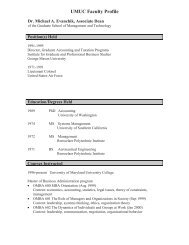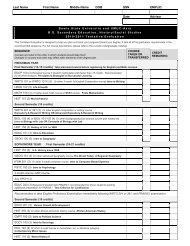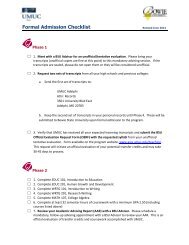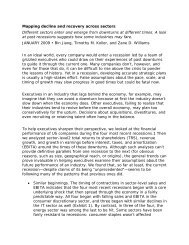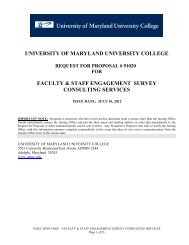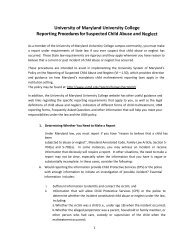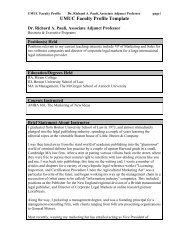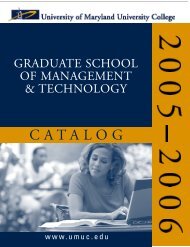A+B. Intro_SJ.1 - University of Maryland University College
A+B. Intro_SJ.1 - University of Maryland University College
A+B. Intro_SJ.1 - University of Maryland University College
Create successful ePaper yourself
Turn your PDF publications into a flip-book with our unique Google optimized e-Paper software.
OMDE 622 The Business <strong>of</strong> Distance Education (3)<br />
Distance education/training is emerging within a highly competitive<br />
environment. Not only does the manager need to know<br />
about cost effectiveness issues, but also must <strong>of</strong>ten be responsible<br />
for such tasks as marketing (local, national, and increasingly<br />
worldwide), choosing between insourcing and outsourcing, balancing<br />
the strong entrepreneurial focus <strong>of</strong> distance education<br />
within more traditional serv i c e -based organizations, and deciding<br />
whether the distance education unit should be integrated or selfsupporting.<br />
The course includes emphasis on the development<br />
<strong>of</strong> business and marketing plans and the use <strong>of</strong> common business<br />
analysis tools. In addition, students explore the rapidly<br />
expanding role <strong>of</strong> private and publicly traded education companies<br />
that are marketing new distance education products and<br />
services to the consumer market.<br />
OMDE 623 Web-Based Learning and Teaching and the<br />
Virtual <strong>University</strong> (3)<br />
The virtual university is a new concept that has recently evolved<br />
as a result <strong>of</strong> the emergence <strong>of</strong> the World Wide Web as a means<br />
<strong>of</strong> delivering higher education. This course covers the brief history,<br />
definitions, and implementations <strong>of</strong> the concept <strong>of</strong> the virtual<br />
university in higher education, government, and business.<br />
The rapidly evolving literature <strong>of</strong> Web-based learning is explore d ,<br />
with special emphasis placed on Web-based pedagogy and course<br />
design. In addition, the impact <strong>of</strong> Web-based technologies is discussed.<br />
The student begins developing Web-based learning environments<br />
and uses Web-based communication tools.<br />
OMDE 625 National and International Policies for Distance<br />
Education in Developing Countries (3)<br />
This course is an exercise in stocktaking, asking the question<br />
“For which purposes has distance education been used in deve l-<br />
oping countries?” and examining the evidence on the extent to<br />
which it has worked. The overall objective <strong>of</strong> this course is to<br />
equip the learner with a knowledge <strong>of</strong> open and distance learning<br />
in the developing world and enable him or her to use conceptual<br />
models to make informed choices among options as a<br />
manager, policy maker, practitioner, or advisor. It will analyze<br />
the roles played by international agencies including bilateral and<br />
multilateral funding agencies, the UN family, regional bodies,<br />
and the specialist agencies. The goal <strong>of</strong> the course is to develop<br />
and use typologies in order to examine the advantages and disadvantages<br />
<strong>of</strong> a range <strong>of</strong> organizational models for distance<br />
education at various educational levels, relating to audience,<br />
educational purpose, and choice <strong>of</strong> technologies.<br />
OMDE 626 Technologies for Distance Education in<br />
Developing Countries (3)<br />
Distance education is a global affair. Most countries have<br />
national distance education efforts. Usually these distance<br />
education systems reflect the internal educational and cultural<br />
structure <strong>of</strong> the country, but increasingly these systems need to<br />
interact with the distance education systems <strong>of</strong> other countries<br />
and cultures. This course considers the similarities and differences<br />
in a wide variety <strong>of</strong> distance education systems, institutions,<br />
and curricula across a variety <strong>of</strong> countries and cultures.<br />
European, Asian, Latin American, and North American models<br />
<strong>of</strong> distance education are explored. Students investigate the<br />
effect <strong>of</strong> political and cultural climate on national distance education<br />
policies. The course emphasizes the role <strong>of</strong> international<br />
organizations in promoting collaborative and cooperative projects<br />
and activities, and a number <strong>of</strong> examples <strong>of</strong> cross-national<br />
projects are examined in depth.<br />
OMDE 631 Ad vanced Technology in Distance Education 1—<br />
Synchronous Learning Systems (3)<br />
This is an advanced course that builds upon OMDE 603<br />
Technology in Distance Education. The course focuses specifically<br />
on synchronous (real-time) technologies such as satellite<br />
broadcasting, microwave broadcasting, public TV broadcasting,<br />
audio conferencing, site-based video conferencing, desktop<br />
video conferencing, application sharing, chat tools, MOOs,<br />
MUDs, and Web-based technologies such as push, pull, realtime<br />
streaming audio and video, and large-scale real-time Web<br />
broadcasting. Some technical details regarding standards-based<br />
technologies, telecommunications technologies, and computer<br />
technologies are examined so that students will be able to effect<br />
i ve l y manage the technical implementation <strong>of</strong> these tools.<br />
OMDE 632 Ad vanced Technology in Distance Education 2—<br />
Asynchronous Learning Systems (3)<br />
This is an advanced course that builds upon OMDE 603<br />
Technology in Distance Education. The course focuses specifically<br />
on asynchronous (non-real-time) technologies such as computermediated<br />
communication (computer conferencing), e-mail, listservers,<br />
archived streaming audio and video, and so forth. Some<br />
technical details are covered relating to telecommunication technologies,<br />
video technologies, and computer technologies to<br />
ensure that the students can effectively manage the technical<br />
implementation <strong>of</strong> these tools.<br />
w w w. u m u c . e d u / g r a d<br />
Un i versity <strong>of</strong> Ma r yland Un i versity <strong>College</strong> | 141 |





